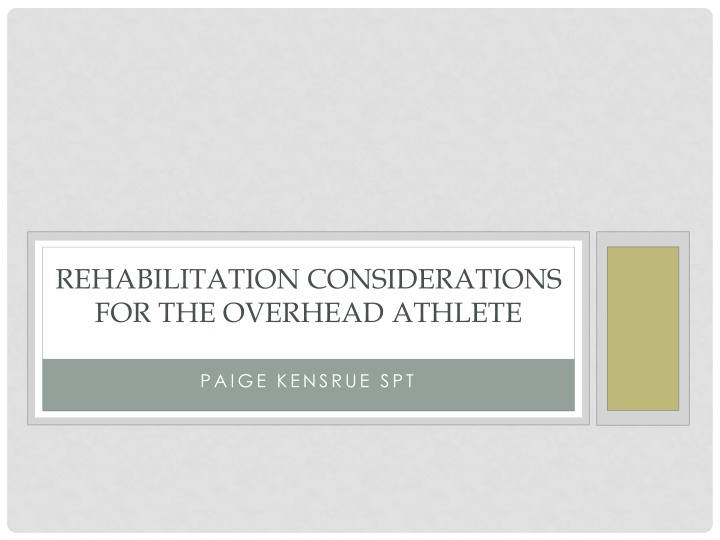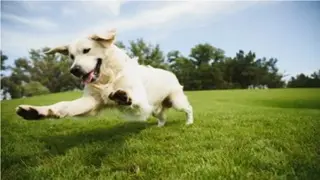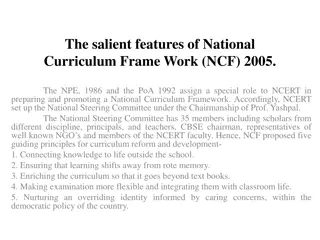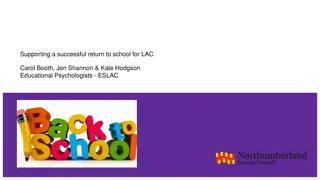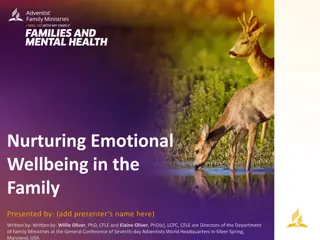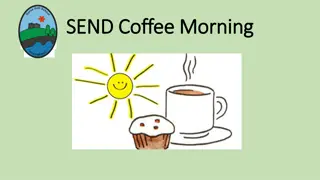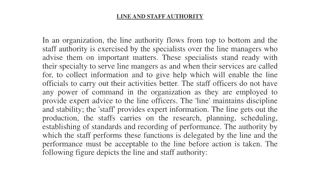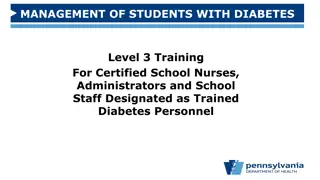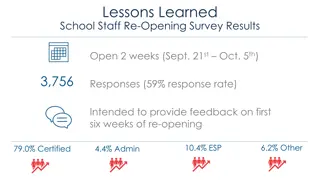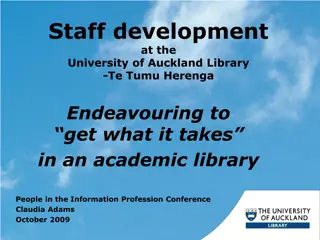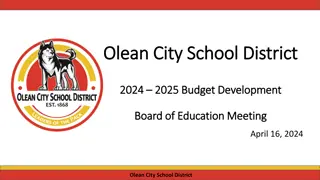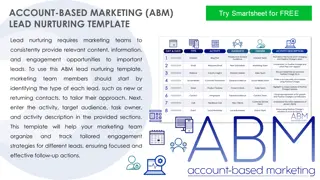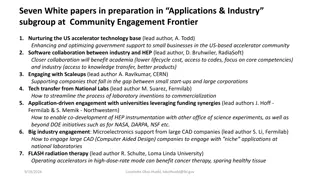The Nurturing School Training: Enhancing Staff Collaboration & Support
Delve into the Nurturing School project's core aspects, including staff roles, expectations, and school improvement plans. Explore the essence of Nurture, attachment theory, Nurturing Principles, and effective communication practices. Gain insights on creating a Nurturing School environment, implementing the project, and fostering staff teamwork. Examine the history and impact of Nurture groups, current research findings, and theoretical foundations. Discover what a Nurturing School entails in terms of resilience, emotional support, and meeting diverse needs.
Download Presentation

Please find below an Image/Link to download the presentation.
The content on the website is provided AS IS for your information and personal use only. It may not be sold, licensed, or shared on other websites without obtaining consent from the author.If you encounter any issues during the download, it is possible that the publisher has removed the file from their server.
You are allowed to download the files provided on this website for personal or commercial use, subject to the condition that they are used lawfully. All files are the property of their respective owners.
The content on the website is provided AS IS for your information and personal use only. It may not be sold, licensed, or shared on other websites without obtaining consent from the author.
E N D
Presentation Transcript
REHABILITATION CONSIDERATIONS FOR THE OVERHEAD ATHLETE PAIGE KENSRUE SPT
OBJECTIVES Review the anatomy and biomechanics of the shoulder and how they relate to the overhead (OH) athlete Review specific OH sport motions Understand bony and soft tissue adaptations that occur with repetitive OH motion Understand the importance of the kinetic chain in OH motions
THE BIG IDEA! Understand specific rehabilitation considerations for the OH athlete in terms of strengthening, ROM, and proprioception.
ANATOMY *Netter Images
ANATOMY Passive Joint Stabilizers! GH ligaments GH capsule Inferior ligament pouch *Netter Images
ANATOMY Serratus Anterior Traps RTC muscles Rhomboids Levator Scapula *Netter images
BIOMECHANICS JOINT MOTION AND MUSCLE ACTION
JOINT MOTION Glenohumeral Joint Most important thing during OH motion is to keep the head of the humerus compressed to the glenoid fossa during arm motion Normal ROM Flexion: 180 IR/ER: 90 in each direction Abduction: 180 (Magee, 2008) OH athlete s ROM GIRD (Wilk, 2002, 2009; van der Hoeven, 2006; Burkhart, 2003)
Scapulothoracic Motions (Borich, 2006)
JOINT MOTION Scapulothoracic Joint Motions of the scapula align the glenoid fossa with the humeral head(Phadke, 2009) Motions at AC and SC joints With arm elevation Upward rotation: 1 for every 2 until 120 elevation then 1-1 (Reinold, 2009) Posterior tilt ~20-40 ER 15-35
MUSCLE ACTION Glenohumeral Deltoid Supraspinatus Infraspinatus and teres minor Subscapularis Scapulothoracic Serratus anterior contributes to ALL scapular movements(Reinold, 2009) Trapezius Pectoralis minor Rhomboids and levator scapulae
Scapulothoracic Force Couples (Andrews, 2008)
SPORT-SPECIFIC DEMANDS Baseball Pitching and throwing Daniel Bard pitch (GO HEELS!) Tennis Serve and overhead strokes Federer serve Don t forget others like swimming, football and handball! Volleyball Serve and spike Slow motion spike
Phases of Pitching (Wilk, 2000)
Phases of Tennis Serve (van der Hoeven, 2006; Kibler, 2006)
EMG Muscle Activity for Tennis Serve (Andrews, 2009)
THE OVERHEAD ATHLETE Humeral torsions Altered length-tension relationships Rotator cuff strengthening Proprioception Kinetic Chain/Linking
HUMERAL TORSION Humeral head retroTORSION Osseous adaptive changes that occur in OH athletes affecting the torsional angle of the humerus (Crockett, 2002; Pieper, 1998) Beneficial adaption allowing for increased ER before soft tissue restraint (Sabick, 2005; Crockett, 2002) Due to repetitive stress on humerus during throwing motion and muscle action (Pieper, 1998; Sabick, 2005) Greatest change between 12-13 yrs when growth plates are open (Wilk, 2009)
Humeral Retrotorsion (Pieper 1998)
HUMERAL TORSION Sabick et al. 2005 Amount of repetitive torque can cause growth plate injuries Crockett et al. 2002 The adaptation comes from the repetitive activity Pieper et al. 2005 The increased retrotorsion can actually be HELPFUL to OH athletes!
ALTERED LENGTH-TENSION RELATIONSHIPS
ALTERED L-T RELATIONSHIPS Slight deviations in positions of the shoulder can cause malalignment of GH muscles and alter muscle forces (Meyers, 2005; Cools, 2007) Muscle Strength Delayed muscle firing (Kennedy, 2009) The scapula! Protraction/Retraction strength ratio (Merolla, 2010; Smith, 2006) Thoracic spine kyphotic posture (Seitz 2011; Kabaeste, 1999)
Altered L-T of deltoid and supraspinatus (Kebaetse, 1999)
ALTERED LENGTH-TENSION RELATIONSHIPS Scapula, scapula, scapula! Scapular dyskinesia a.k.a. SICK scapula Scapular malposition Inferior medial border prominence Coracoid pain and malposition DyKinesis of scapular movement (Burkhart, 2003) Types of SICK scapula I: inferior medial border prominence (example) II: medial scapular border prominence III: prominence of the superiomedial border
ALTERED L-T RELATIONSHIPS Special testing of the scapula (Burkhart, 2003) Scapular assistance test (SAT) Assist upward rotation + test = relief of symptoms Scapular retraction test (SRT) Manually positioning and stabilizing entire medial border during active abduction + test = increased strength with stabilization or decreased pain symptoms
SRT and SAT Testing (Burkhart, 2003)
STRENGTHENING Not all strength training is created equal! Different methods required for strength training OH athletes vs. other shoulder patients GH rotational and scapulothoracic strength ratios are going to be different! (Wilk 2009) Consider what the muscles need to do during the motion
STRENGTHENING Thrower s Ten Program (Wilk 2002, 2009) Implemented in intermediate stage of rehab Includes exercises for the shoulder, wrist and elbow ER/IR at 0 and 90 abduction and side-lying Scaption Push-ups and press-ups Elbow flexion/extension Wrist flexion/extension, supination/pronation Prone exercises for scapulothoracic musculature
STRENGTHENING Fatigue Can cause superior translation of humeral head during initiation of abduction (Wilk 2009) Causes altered kinematics, force couples and muscle activation patterns (Joshi, 2011) Decreased sensorimotor and proprioception activity (Tripp, 2004) A relationship exists between fatigue, neuromuscular control and proprioception (Bowman, 2006)
FATIGUE Tripp et al. 2004 Functional fatigue program produced increased proprioceptive error Bowman et al. 2006 Fatigue caused increase in deceleration time during throw Szucs et al. 2009 Altered clavical and scapulothoracic positioning Joshi et al. 2011 Force couple between LT and infraspinatus altered with glenohumeral ER fatigue
FATIGUE Infraspinatus THE MOST BANG FOR YOUR BUCK Teres Minor Serratus Anterior Subscapularis Video Lower Trapezius
FATIGUE Video
STRENGTHENING Eccentrics Need the appropriate balance of strength (Kennedy, 2009) Concentric ER : Eccentric IR during arm-cocking phase (Yildiz, 2006) Concentric IR : Eccentric ER during deceleration phase (Noffal, 2003; Kennedy, 2009)
ECCENTRICS Noffal 2003 Lower ratio eccentric ER strength : concentric IR strength - indicating that athletes are gaining in one area and not the other Yildiz et al. 2006 Different ratios are found based on the phase of throwing Arm-cocking phase Deceleration phase
ECCENTRICS Video
PLYOMETRICS **Used in the advanced strengthening phase (Wilk, 2009) Quick stretch of muscle from eccentric action to concentric action (Davies, 2001; Wilk 2002, 2009) Eccentric phase amortization phase concentric phase Dynamic neuromuscular stabilization (Carter, 2007) May facilitate neural adaptations to enhance proprioception, kinesthesia, and muscle performance
PLYOMETRICS Heiderscheit et al. 1996 Increase in concentric/eccentric strength Swanik et al. 2002 Plyometric training improved performance on reposition and kinesthetic testing Carter et al. 2007 Significant increase in throwing velocity Peters et al. 2007 No weakness, pain or muscular fatigue at end of tx
PLYOMETRICS Ballistic 6 Exercises (Pretz) ER with theraband @ 0 shoulder abduction ER with theraband @ 90 shoulder abduction Overhead soccer throw-in with medicine ball 90/90 ER side-throw Deceleration baseball throw (can be done standing or half- kneeling) Example Baseball throw
PLYOMETRICS Wilk et al. 2002, 2009 Two-handed exercises using trampoline Progress to one-handed drills
PLYOMETRICS Video
PROPRIOCEPTION Somatosensory system Proprioceptive mechanoreceptors located in the glenohumeral ligaments and labrum (Safran, 2001) Helps to promote dynamic stability of the joint (Wilk, 2002) Microtrauma might affect this feedback loop (Safran, 2001) Components (Tripp, 2006) Kinesthesia Joint position sense (active or passive) Neuromuscular control
